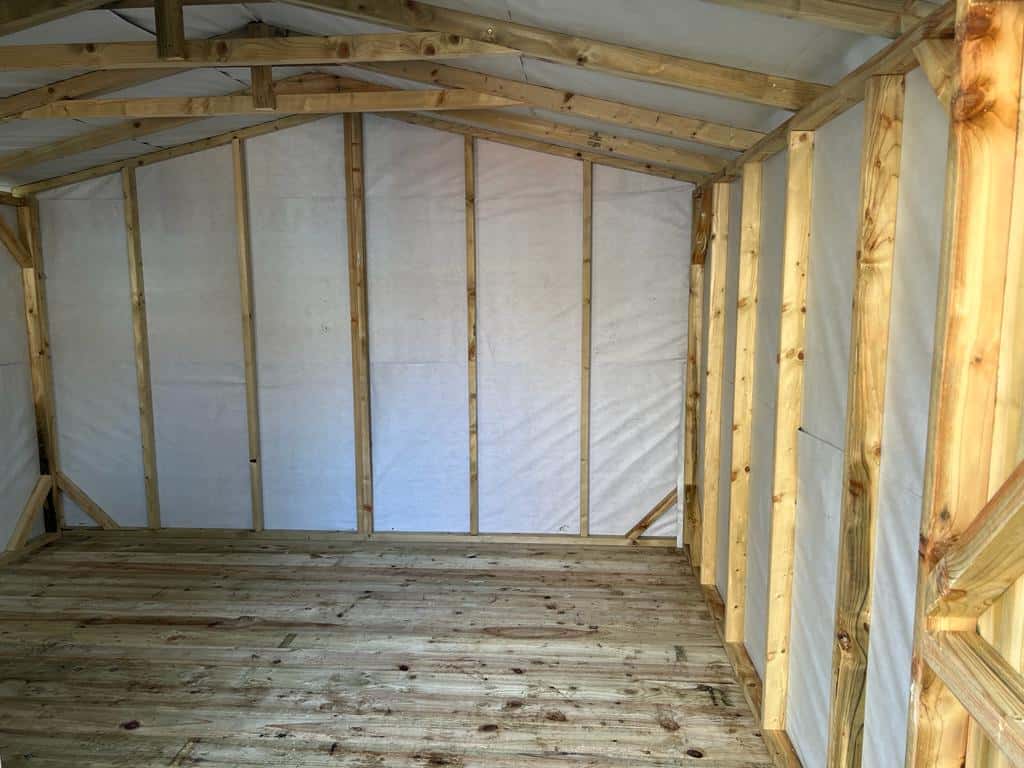If you’re considering adding a shed to your garden, you might be tempted to build it yourself. Knowing how to build a shed can be a rewarding DIY project, offering both a functional space and a sense of achievement. However, it’s crucial to plan carefully and understand each step of the process, and know that the potential costs of building a shed yourself may not be any cheaper than the considerably quicker and easier option of choosing a shed from a retailer such as ourselves. In this comprehensive guide, we will walk you through the main aspects of shed construction, from choosing the right foundation to selecting walls, doors, windows, roofing, and even discussing ongoing maintenance. Let’s get started!
Step 1: Choosing the Right Foundation
Before you begin building your shed, it’s essential to choose the right foundation. A solid, level foundation is critical to the stability and longevity of your shed. Without a proper foundation, you risk structural issues down the road, such as sagging floors or misaligned doors.
There are several types of foundations to consider when building a shed:
- Concrete : This is one of the most durable and long-lasting foundations. A concrete slab offers a stable base and is perfect for larger sheds or those storing heavy equipment.
- Pavers/Slabs: Using pavers is a quicker and easier option compared to concrete. This foundation type is also durable and allows for water drainage beneath the shed.
- Decking or Timber Base: While not as durable as the above two options, these will help keep your shed up off the ground and protect it from moisture and pests.
For more detailed information on which foundation is best for your shed, visit our article dedicated to suitable shed foundations.
Step 2: Building the Walls, Doors, and Windows
Once your foundation is in place, it’s time to move on to constructing the walls. The design of your shed’s walls, doors, and windows will not only determine how the shed looks but also how functional and secure it is.
Wall Construction
The walls of your shed provide the framework that holds everything together, so it’s essential to use high-quality timber and ensure the structure is sturdy. The thickness of the timber will play a major role in how well your shed stands up to the test of time and weather. For example, sheds with thicker, heavy-duty timber will be more durable and better insulated.
Additionally, ensure that your timber is treated to protect against rot and insects. We recommend using tanalised timber, as this process extends the life of the wood and protects it from moisture damage. If you want to learn more about the benefits of tanalisation, check out our article on how to treat your garden shed.
Doors and Windows
When planning the design of your shed, you should also consider the placement and size of the doors and windows. These choices will influence how much natural light enters the shed and how secure it will be.
- Windows: Larger windows will allow more natural light in, making the shed more usable as a workspace or hobby room. However, if security is a concern, you might opt for smaller windows or add locks to prevent unauthorised access.
- Doors: The type of door you choose will also impact security. Double doors are convenient for moving large items in and out, but they may require more reinforcement to ensure they are secure.
When building a shed, keep in mind that sourcing materials yourself may not be cheaper than buying from a reputable supplier. Manufacturers like Midlands Sheds and Summerhouses receive discounts on timber, making their pre-built options more cost-effective. Plus, there’s the added time cost of building the shed yourself. Check out our shop for high-quality, ready-to-install shed options.
Step 3: Roofing Options for Your Shed
The roof of your shed is another critical aspect that must be chosen carefully. Your choice of roofing material will affect both the appearance and durability of your shed.
Roofing Types
Here are the most common types of roofing for sheds:
- Felt roofing: This is one of the most affordable options, commonly used for garden sheds. However, felt roofing has a limited lifespan and may need replacing every few years.
- Shingles: Shingles offer a more attractive and durable option compared to felt. Asphalt shingles are the most popular due to their affordability and ease of installation, while cedar shingles provide a more natural look.
- Metal roofing: Metal roofs are highly durable and can last decades without much maintenance. They’re also fire-resistant, making them an excellent option for sheds that house valuable equipment.
- EPDM rubber roofing: This is a highly durable and weather-resistant material that’s ideal for larger or more permanent sheds. EPDM rubber roofing offers excellent protection against leaks and is long-lasting.
For more information on the benefits of EPDM rubber roofing, visit our page on EPDM Rubber Roofing.
Step 4: Guttering and Ongoing Maintenance
Once your shed is built and the roof is installed, it’s time to consider additional features that can help preserve the structure and make it more functional. Guttering, for example, is a small addition that can have a big impact.
Guttering
Installing guttering on your shed will help direct rainwater away from the structure, preventing water damage to the foundation and reducing the risk of rot. Guttering can be attached to the edge of the roof and connected to a water butt to collect rainwater. This is an environmentally friendly option that also allows you to reuse water for your garden.
Ongoing Maintenance
No matter how well-built your shed is, ongoing maintenance is necessary to ensure its longevity. Regularly inspect your shed for any signs of wear and tear, particularly after storms or heavy rainfall. Pay close attention to the roof, as small leaks can cause significant damage if left unchecked.
Here are a few tips for maintaining your shed:
- Reapply wood treatment: Over time, even treated timber can start to show signs of weathering. It’s important to reapply a wood treatment every couple of years to protect the wood from moisture and insects.
- Check for rot: Inspect the base of your shed regularly for signs of rot, especially if it’s in contact with the ground. If you spot any areas of concern, repair or replace the affected timber immediately.
- Clean the roof and gutters: Leaves and debris can collect on the roof and in the gutters, potentially causing blockages or moisture buildup. Clear the roof and gutters regularly to ensure water can flow freely and prevent any damage.
By keeping up with regular maintenance, you can ensure that your shed lasts for many years to come.
Final Thoughts on How to Build a Shed
Building a shed can be a rewarding project, but it requires careful planning and attention to detail. From choosing the right foundation to selecting the ideal roofing and maintaining the structure over time, each step plays an important role in ensuring your shed stands the test of time.
However, it’s also worth considering whether building a shed yourself is the most cost-effective and time-efficient option. At Midlands Sheds and Summerhouses, we offer a wide range of high-quality bespoke sheds, made from durable tanalised timber and built to last. With competitive pricing and customisable options, you may find that purchasing a ready-made shed is a smarter investment than tackling the entire project yourself.
Visit our website to explore our range of bespoke sheds and find the perfect solution for your garden today!



